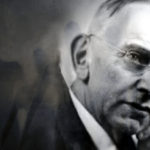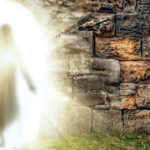In some earlier blog posts, later collected as an essay, I talked about a diamond as an image of the oversoul or higher self, with each facet of the diamond corresponding to a different incarnate personality. Here I’d like to expand on that idea, taking the purely imaginary case of a particular oversoul and its incarnations.
Let’s say that this oversoul has incarnated three times, first as Enos, a peasant; then as Redbeard, a pirate; and currently as Dave, a podiatrist. In this case the diamond has three facets. They are separate and distinct from each other, but they are all part of the diamond itself.
While incarnated, Dave is largely unconscious of the oversoul. I use the word “unconscious” deliberately, because I think that the unconscious (or subconscious) mind is the point of access to the higher self. The higher self is not the subconscious; on the contrary, it would more accurately be characterized as a superconsciousness. Both the subconscious and the superconscious are part of what F. W. H. Myers termed “the subliminal self.”
Dave is not entirely cut off from his higher self; intuitions and inspirations come to him from the oversoul, by way of dreams, meditation, or reverie. And it is possible for Dave to cultivate his openness to such information, expanding his awareness. Still, during his earthly lifetime, the oversoul is mostly out of sight – not unlike the 9/10 of an iceberg that lies submerged.
As a young child, Dave remembered a previous life in vivid detail – the life of Redbeard the pirate.* By the age of eight, these memories had faded. Young children have a more immediate connection to the oversoul; they do not draw a clear distinction between reality and imagination, or between the products of conscious thought and subconscious imagery. They are open to input from their higher self in a way that most adults are not. Dave remembered Redbeard’s life, not because the Dave personality had previously existed as the Redbeard personality, but because both personalities stem from a common source, and the young Dave was in contact with that source.
It seems he was most likely to remember only the oversoul’s most recent incarnation. He remembered Redbeard, but not Enos. If each incarnation is a stepping stone to the next one along a path of continuous growth, then it might be expected that the current personality would be most closely in touch with the last one. The Dave personality is, in some ways, an outgrowth of the Redbeard personality. In some cases, this outgrowth results in the carryover of specific personality traits or even physical traits (birthmarks or birth defects corresponding to wounds or injuries sustained in the life if the previous personality).
Children are more likely to remember a past life that ended abruptly, usually because of violence or the sudden onset of disease. Most spontaneous past-life memories reported by young children are of this type. Possibly this is because a life interrupted represents a partially missed opportunity, which the new incarnation is intended to correct. Redbeard, not unlike many pirates, lived fast and died young, before he could learn the lessons planned by the oversoul; Dave represents the chance to complete this phase of the oversoul’s education.
Dave, as an adult, has a near-death experience in which he finds himself, in his own recognizable human body, meeting departed friends and loved ones in a beautiful garden. The experience plays out this way because he is still identified with the Dave personality and not with the oversoul. At a certain point in his NDE, Dave encounters a being of light, which he first interprets as Jesus (a holdover from his religious upbringing) and then, more broadly, as God. Actually, the being of light is the oversoul, which Dave, who is consciously unfamiliar with it, interprets as an outside entity. He simply cannot imagine himself as part of this radiant superconsciousness, which is so far above his own limited awareness. But as the being of light draws nearer, he finds himself merging with it – though only partially and temporarily. For Dave, this is an unforgettable experience. It feels as if he has merged with God, become one with everything, and attained infinite wisdom. In fact, however, he has merged – not with God – but with his own oversoul, and his wisdom, while greatly expanded, falls well short of omniscience.
Sometime after his NDE, Dave goes to a hypnotist who puts him in a deep trance and regresses him to a point before his own birth. In that state he experiences a “between lives” existence, as reported by the hypnotized subjects of Michael Newton, Brian Weiss, and others. Because he has been regressed to a stage before birth — that is, before the Dave personality came into existence — he is now identifying with the oversoul, which is the source of that personality. As a result, Dave’s recollection of his between lives existence differs from his NDE. In his NDE he was still identifying with the Dave personality, so he experienced himself having Dave’s body, meeting Dave’s friends, and seeing religious imagery consistent with Dave’s belief system. In his hypnotic regression, he is not identifying with the Dave personality but with the oversoul, so he experiences himself without a human body and without Dave’s personal characteristics. Typically, Newton’s subjects saw themselves and their friends (who are other oversouls) as shapes of light in different colors, moving through an abstract geometrical landscape. They had a full recollection of their various incarnations, as well as a full memory of their between-lives schooling and associations.
In short, the being of pure light moving through an unearthly geometric environment is the oversoul, while the recognizable human form moving through a garden paradise is the incarnate personality.
But which one is the real locus of consciousness? Is it Dave or Redbeard or Enos or the oversoul? Arguably, each one of them represents the same locus of consciousness, only viewed from a different perspective. It’s a Flatland thing. Flatland is the classic 19th century satire by Edwin Abbott that presents two-dimensional people living in a two-dimensional world. When one of them is lifted into Spaceland, our three-dimensional plane, he sees things from a whole new perspective. Some of what he sees would have been inconceivable to him when he was still in Flatland. For instance, he can now see inside a windowless Flatland house even if all the doors are closed. Why? Because Flatland houses have no roofs (there is no third dimension, hence no up or down). The displaced Flatlander, hovering over the flat sheet of paper on which Flatland is drawn, can simply look down and see the interior of the house. It’s a very simple and obvious, but only if one has the perspective afforded by the third dimension. My guess is that the spiritual realm has additional dimensions not only of space but of consciousness, and that these additional dimensions provide the perspective necessary to resolve what appear to be impossible contradictions in our realm.
When the hypnotist regresses Dave to an even earlier point, he remembers the life of Redbeard the pirate and even the life of Enos the peasant. But he reports those lives from a somewhat detached perspective, because he is still predominantly identifying with the oversoul. I remember that one of Newton’s patients, after discussing a life lived as a woman two or three hundred years ago, spoke some words to this effect: “the experience was good for me, and I believe it was good for her, too.” (I’m paraphrasing from memory.) I always found this rather confusing. The hypnotized subject seemed to be treating the incarnate woman as a separate person, rather than as himself in a different guise. But in terms of our present hypothesis, the statement makes sense. It is the oversoul commenting on a particular incarnate personality. Dave’s oversoul could be expected to make the same kind of statement: “The experience of the Dave personality was useful to me, and I believe it was a positive experience for the Dave personality itself.”
Incidentally, hypnotic past-life regression is often explained in terms of cryptomnesia — the purported ability to remember even the most trivial details of books and movies that the person encountered decades earlier. Though these details have been consciously forgotten, they are aid to be retained in the subconscious and to be brought forward under hypnosis. There’s no doubt that many, though not all, regression cases can be explained this way (see The Search for Yesterday, by D. Scott Rogo), but the explanation itself raises interesting questions. By what mechanism does the mind retain all these details, and how does hypnosis afford access to them? I would suggest that the details are retained by the superconscious, and that a deep hypnotic trance opens the door to this fund of knowledge. I’d also suggest that the life review reported in some NDEs involves immersion in this memory archive. And since the oversouls collectively represent all the souls that have ever incarnated, they collectively have a complete record of all memories and subjective experience — a treasure trove known in mystical circles as the Akashic records.
Continuing his spiritual exploration, Dave starts going to mediums. Some appear to have genuine paranormal abilities. He finds that they talk about different “levels of vibration” corresponding to different spiritual planes. He begins to suspect that the higher vibrational levels correspond to higher dimensions of consciousness — that the mediums are really talking about changes in the frequency of consciousness itself. (The channeled book The Unobstructed Universe makes this point.) The Dave personality exists at one vibrational level, while the oversoul exists at a higher vibrational level. Moreover, as Dave learned from his hypnotic regression, the oversoul itself is part of a select group of oversouls who work together on their mutual development – what might be called a collective oversoul. And it is certainly within the realm of possibility that each collective oversoul is part of a still higher collective, and so on, as consciousness expands in widening ripples.
Dave also finds that discarnate personalities speaking through mediums say they must lower their vibrational level in order to communicate with those of us on earth. He speculates that a deceased person, having transitioned to the afterlife, has greater access to the oversoul and thus is raised in vibration – just as he was, temporarily, when he partially merged with the being of light. The thin pipeline connecting the Dave personality to the oversoul’s superconsciousness via the subconscious was expanded, albeit briefly, into a wide channel. He suspects that, had the NDE continued, he would have retained his own personality but also enjoyed access, on a continuing basis, to a wider spectrum of the oversoul’s awareness. The deceased people speaking through the mediums are in this condition of expanded consciousness, but to communicate with earthly human beings, they must restrict their newfound access to the oversoul and shrink down to something close to their original limitations. This is why spirit communicators often say that they can only express a fraction of who they now are and what they now know. It is also why spirit communication is so difficult for those on the other side.
Another thing Dave notices is that a medium never says that a given communicator is unavailable, having already reincarnated. Skeptics sometimes seize on this fact to question either mediumship or reincarnation. But if the diamond hypothesis is correct, then we would expect all deceased personalities (Enos and Redbeard, for instance) to remain in the spirit world; reincarnation involves the manifestation of a new personality extruded from the oversoul, not the recycling of a previous personality.
What Dave is learning is that he is part of something larger than himself, which is in turn part of something still larger. His ego may resist this idea; it wants to be Mr. Big! His spiritual journey involves letting go of the ego, at least to some degree. Not coincidentally, by diminishing his attachment to the ego, he reduces his identification with the Dave personality and increases his identification with the oversoul, which he may experience, subjectively, as “the witness” who observes his thoughts and actions in the background — a witness who becomes apparent during those meditative moments when he quiets his chattering mind.
*I’m using some artistic license in having the young Dave recall a life as a pirate, since children who recall a past life almost always remember a life that ended only a few months or years before they were born. Redbeard presumably died much earlier than that.








